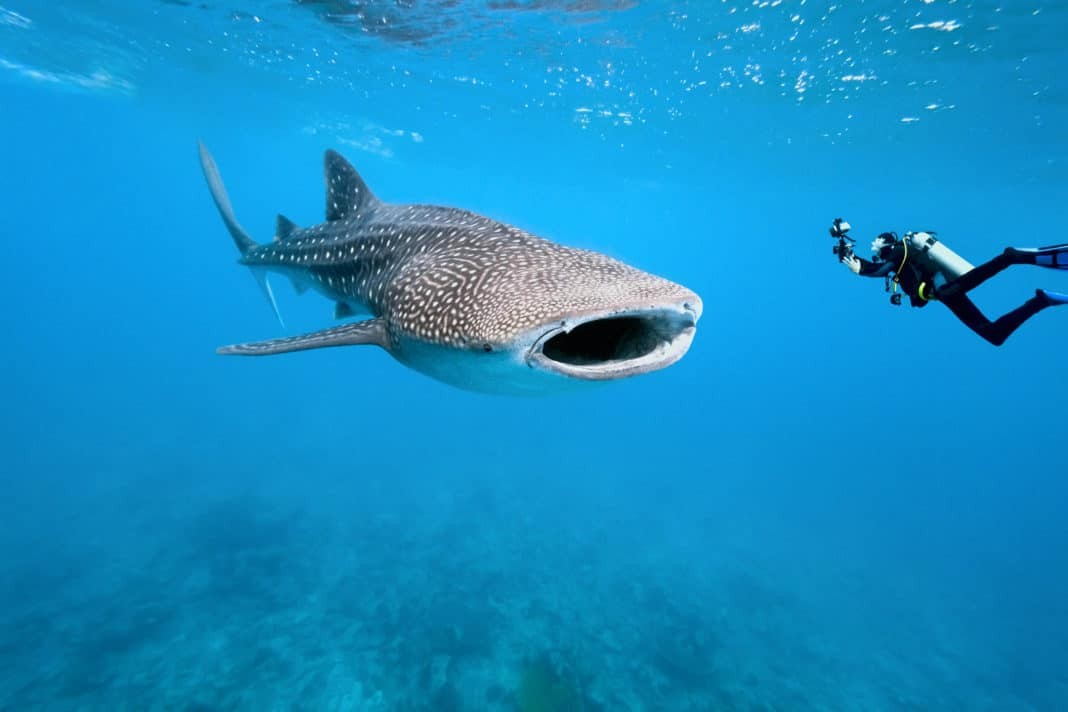For humans, the concept of social distancing is really just a few months old. But for a certain whale shark, it’s something she had been practicing for many years.
“Rio Lady,” a mature, 26-foot whale shark tagged in 2018, has been tracked by research scientists at Nova Southeastern University’s (NSU) Guy Harvey Research Institute and Ch’ooj Ajauil AC for nearly 20 months, making this the longest, high-resolution position track for this globally endangered species. But this wasn’t the first time she was tagged by researchers.
Eleven years prior and with support from Georgia Aquarium, scientists from Mote Marine Laboratory and Ch’ooj Ajauil AC’s Executive Director Rafael de la Parra first tagged her in August 2007 in the Gulf of Mexico near Isla Mujeres, Mexico, where whale sharks annually aggregate to feed. Based on her ample girth, the researchers suspected the shark was pregnant. At that time, the researchers used a pop-up satellite tag, and as the name implies, the tag “popped up” about five months later and nearly 5,000 miles (8047 km) away in the southern Atlantic Ocean, near the Rocks of Saint Peter and Saint Paul between the African continent and Brazil. This led de la Parra to nickname her Rio Lady.
She wasn’t seen again until the summer of 2011.
According to Mahmood Shivji, Ph.D., a professor in NSU’s Halmos College of Natural Sciences and Oceanography and the director of NSU’s GHRI:
“After the original tag came off, she kind of just went dark. Talk about social distancing – she kept her distance for nearly four years. What’s also interesting is that Rio Lady’s new track is strikingly different from her travel path after she was first tagged in 2007. Her recent 20-month journey shows she travelled through the national waters of at least five countries in the Caribbean and Gulf of Mexico, making you wonder where else she explored in the years she wasn’t tracked.”
After she was first tagged, her long trek while pregnant to the middle of the Atlantic made this whale shark a media celebrity.
Mote’s Robert Hueter, Ph.D., lead scientist of the research in 2007 said:
“Rio Lady immediately became a superstar for her species. She gave us a major clue about where whale sharks may be giving birth to their young, in offshore waters of the open ocean far from their nearshore feeding grounds.”
Rio Lady ditched her social distancing in 2011, reappearing annually at the Mexico aggregation site from 2011 to 2018. Then in August 2018, de la Parra, working on a collaborative project with NSU GHRI scientists, tagged her in almost the exact location where she was originally tagged. This time, the researchers affixed a higher resolution Smart Position and Temperature (SPOT) satellite tag to Rio Lady’s fin, obtaining more accurate positions of her locations from this tag.
“Rio Lady’s tag information has given us better insight into where whale sharks go, for how long and other factors that can contribute to our understanding of these gentle giants. Our research on whale sharks spans more than 15 years and it’s always an achievement when we have new data to help us make informed decisions about where to look next or questions that still need answers.”
Whale sharks are the largest fish in the sea, which along with mako sharks, tiger sharks, oceanic whitetips, sand tigers, smooth hammerheads and more are monitored at NSU’s GHRI as part of ongoing research of the marine ecosystem. The GHRI studies many aspects of shark-life, from migratory patterns to their genomes, in order to protect these animals for future generations. An endangered species, whale sharks are harvested for their fins, oils, meat and more and can also fall victim to ship strikes during their migrations.
The trek of Rio Lady and other sharks NSU’s GHRI researchers have tagged can be found at nova.edu/sharktracking.

